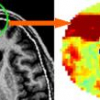Free Online Productivity Tools
i2Speak
i2Symbol
i2OCR
iTex2Img
iWeb2Print
iWeb2Shot
i2Type
iPdf2Split
iPdf2Merge
i2Bopomofo
i2Arabic
i2Style
i2Image
i2PDF
iLatex2Rtf
Sci2ools
ISBI
2002
IEEE
2002
IEEE
Statistical shape model for automatic skull-stripping of brain images
This paper presents a statistical shape model for automatic skull stripping of MR brain images. A surface model of the brain boundary is hierarchically represented by a set of overlapping surface patches, each of which has elastic properties and deformation range that is learned from a training set. The model's deformation is hierarchical which adds robustness to local minima. Moreover, the deformation of the model is constrained and guided by global shape statistics. The model is deformed to the brain boundary by a procedure that matches the local image structures and evaluates the similarity in the whole patch rather than on a single vertex. The experimental results show high agreement between automatic and supervised skull-stripping results.
| Added | 20 Nov 2009 |
| Updated | 20 Nov 2009 |
| Type | Conference |
| Year | 2002 |
| Where | ISBI |
| Authors | Zhiqiang Lao, Dinggang Shen, Christos Davatzikos |
Comments (0)

